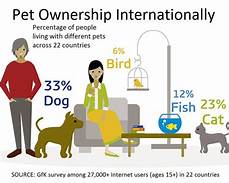What Percentage of People Have Pets?
Pets are beloved companions that bring joy and unconditional love into our lives. But just how common is pet ownership? This article delves into the statistics of pet ownership worldwide, exploring the factors that influence pet-keeping and the benefits that pets provide to our physical and mental well-being.

Global Pet Ownership Statistics
According to a 2021 study by the American Pet Products Association (APPA), approximately 67% of U.S. households, equivalent to 85 million homes, own at least one pet. This translates to nearly 230 million pets across the country, including dogs, cats, birds, fish, and other companion animals.
Globally, the pet ownership rate varies widely across countries. In some regions, such as Europe and North America, pet ownership is relatively high, ranging from 50% to 80% of households. In contrast, pet ownership rates are lower in developing countries, where access to veterinary care and pet supplies may be limited.
Factors Influencing Pet Ownership
Several factors influence the decision to own a pet, including cultural norms, lifestyle, and personal preferences.
- Culture: In some cultures, pet ownership is deeply ingrained in society, with pets considered integral members of the family. Conversely, in other cultures, pet ownership may be less common or even taboo.
- Lifestyle: People with active lifestyles or who spend long hours away from home may find it challenging to provide adequate care for a pet. Conversely, those living in single-person households or with children often find that pets provide companionship and emotional support.
- Personal Preferences: Some individuals simply prefer the company of animals and derive great joy from interacting with them. Others may be allergic to pets or have specific living arrangements that make pet ownership impractical.
Benefits of Pet Ownership
Research has consistently shown that pet ownership can have positive effects on our physical and mental health. Some of the benefits include:
- Reduced Stress: Interacting with pets can lower blood pressure, heart rate, and cortisol levels, which are hormones associated with stress. Additionally, petting an animal can release oxytocin, a hormone that promotes bonding and relaxation.
- Improved Mood: Pets can provide companionship and entertainment, reducing feelings of loneliness and isolation. Studies have shown that pet owners tend to have higher levels of happiness and well-being.
- Increased Activity: Walking a dog or playing with a cat can encourage physical activity, which is essential for maintaining a healthy weight and reducing the risk of chronic diseases.
- Enhanced Socialization: Pets can act as social catalysts, helping people connect with others in their community. Dog owners, for example, often socialize with other dog owners while walking their pets.
- Better Cognitive Function: Studies have shown that interacting with pets can improve cognitive function and reduce the risk of dementia in older adults.
Conclusion
The percentage of people who have pets varies around the world, influenced by cultural norms, lifestyle, and personal preferences. However, the benefits of pet ownership are undeniable. Pets can enrich our lives, providing companionship, reducing stress, improving our mood, and promoting physical and mental well-being.
Declaration: All article resources on this website, unless otherwise specified or labeled, are collected from online resources. If the content on this website infringes on the legitimate rights and interests of the original author, you can contact this website to delete it.





